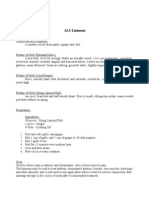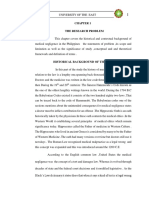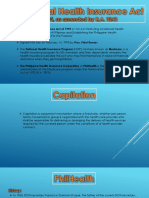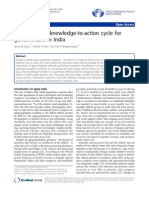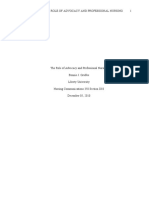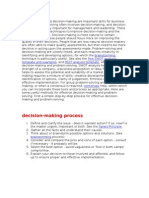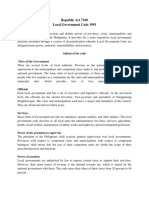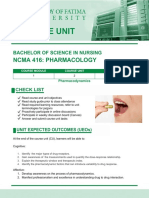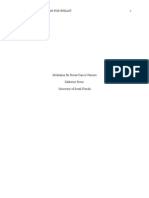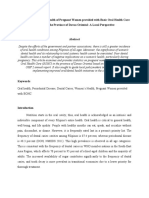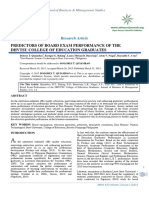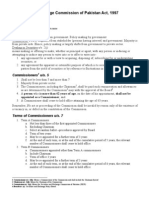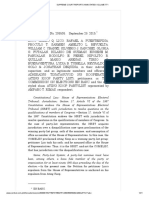0 ratings0% found this document useful (0 votes)
260 viewsInformation On Department of Social Welfare and Development
Information On Department of Social Welfare and Development
Uploaded by
15-0001The document discusses the mandate, functions, and authority of the Department of Social Welfare and Development (DSWD) in the Philippines. The DSWD is mandated to provide assistance to local governments, NGOs, and other groups in implementing programs to alleviate poverty and empower disadvantaged communities. Its functions include formulating policies, developing social programs, registering and monitoring social welfare organizations, and providing technical assistance. The Secretary oversees the DSWD and is assisted by Undersecretaries and Assistant Secretaries who supervise different departments and bureaus.
Copyright:
© All Rights Reserved
Available Formats
Download as DOCX, PDF, TXT or read online from Scribd
Information On Department of Social Welfare and Development
Information On Department of Social Welfare and Development
Uploaded by
15-00010 ratings0% found this document useful (0 votes)
260 views5 pagesThe document discusses the mandate, functions, and authority of the Department of Social Welfare and Development (DSWD) in the Philippines. The DSWD is mandated to provide assistance to local governments, NGOs, and other groups in implementing programs to alleviate poverty and empower disadvantaged communities. Its functions include formulating policies, developing social programs, registering and monitoring social welfare organizations, and providing technical assistance. The Secretary oversees the DSWD and is assisted by Undersecretaries and Assistant Secretaries who supervise different departments and bureaus.
Original Description:
:)
Original Title
Information on Department of Social Welfare and Development
Copyright
© © All Rights Reserved
Available Formats
DOCX, PDF, TXT or read online from Scribd
Share this document
Did you find this document useful?
Is this content inappropriate?
The document discusses the mandate, functions, and authority of the Department of Social Welfare and Development (DSWD) in the Philippines. The DSWD is mandated to provide assistance to local governments, NGOs, and other groups in implementing programs to alleviate poverty and empower disadvantaged communities. Its functions include formulating policies, developing social programs, registering and monitoring social welfare organizations, and providing technical assistance. The Secretary oversees the DSWD and is assisted by Undersecretaries and Assistant Secretaries who supervise different departments and bureaus.
Copyright:
© All Rights Reserved
Available Formats
Download as DOCX, PDF, TXT or read online from Scribd
Download as docx, pdf, or txt
0 ratings0% found this document useful (0 votes)
260 views5 pagesInformation On Department of Social Welfare and Development
Information On Department of Social Welfare and Development
Uploaded by
15-0001The document discusses the mandate, functions, and authority of the Department of Social Welfare and Development (DSWD) in the Philippines. The DSWD is mandated to provide assistance to local governments, NGOs, and other groups in implementing programs to alleviate poverty and empower disadvantaged communities. Its functions include formulating policies, developing social programs, registering and monitoring social welfare organizations, and providing technical assistance. The Secretary oversees the DSWD and is assisted by Undersecretaries and Assistant Secretaries who supervise different departments and bureaus.
Copyright:
© All Rights Reserved
Available Formats
Download as DOCX, PDF, TXT or read online from Scribd
Download as docx, pdf, or txt
You are on page 1of 5
MANDATE
Consistent with the provisions of the Administrative Code of 1987 and of RA
7160 (Local Government Code), the DSWD is hereby mandated to provide assistance
to local government units (LGUs), non-government organizations (NGOs), other
national government agencies (NGAs), peoples organizations (POs) and other
members of civil society in effectively implementing programs, projects, and services
that will alleviate poverty and empower disadvantaged individuals, families and
communities for an improved quality of life.
FUNCTIONS
As the lead agency in social welfare and development, the Department exercises
the following functions
Formulates policies and plans which provide direction to intermediaries and other
implementers in the development and delivery of social welfare and development
services.
Develops and enriches existing programs and services for specific groups, such
as children and youth, women, family and communities, solo parents, older
persons and Persons with Disabilities (PWDs);
Registers, licenses and accredits individuals, agencies and organizations
engaged in social welfare and development services, sets standards and
monitors the empowerment and compliance to these standards.
Provides technical assistance and capability building to intermediaries; and
Provides social protection of the poor, vulnerable and disadvantaged sector,
DSWD also gives augmentation funds to local government units so these could
deliver SWD services to depressed municipalities and barangays and provide
protective services to individuals, families and communities in crisis situation.
POWER
The Department of Social Welfare and Development (DSWD) (Filipino: Kagawaran
ng Kagalingang Panlipunan at Pagpapaunlad) have a power under the executive
department of the Philippine Government which is responsible for protecting the
social welfare rights of Filipinos and promoting social development. The DSWD is
currently under the leadership of Department Secretary Dinky Soliman.
There is hereby created a Department of Social Welfare, hereafter referred to as the
Department, which shall develop and implement a comprehensive social welfare
program consisting of (1) preventive and remedial programs and services for
individuals, families and communities; (2) protective, remedial and developmental
welfare services for children and youth; (3) vocational rehabilitation and related
services for the physically handicapped, ex-convict and individuals with special
needs; and (4) training and research and special projects.
HISTORICAL BACKGROUND
Social welfare as a basic function of the state was a concept that materialized
only after the Second World War, although different groups were undertaking
pockets of social work in the first decade of the American occupation in the
country. After the war, the Philippine government gradually assumed the major
responsibility for social welfare.
1915 - The Public Welfare Board (PWB) was created. Its functions were to study,
coordinate and regulate all government and private entities engaged in social
services.
1921 - The PWB was abolished and replaced by the Bureau of Public Welfare
under the Department of Public Instruction.
1939 - Commonwealth Act No. 439 created the Department of Health and Public
Welfare
1941- The Bureau of Public Welfare officially became a part of the Department of
Health and Public Welfare. In addition to coordinating services of all public and
private social welfare institutions, the Bureau also managed all public child-caring
institutions and the provision of child welfare services.
1947 - President Manuel A. Roxas abolished the Bureau of Public Welfare and in
its place created the Social Welfare Commission (SWC) under the Office of the
President.
1948 - President Elpidio Quirino created the Presidents Action Committee on
Social Amelioration (PACSA) to effect socio-economic reforms in the countryside
to counteract social unrest.
1951 - The SWC and PACSA were merged into the Social Welfare
Administration (SWA) which marked the beginning of an integrated public welfare
program.
1968 - Republic Act 5416 known as the Social Welfare Act of 1968 elevated the
SWA into a Department, placing it under the executive branch of government in
equal status with other social agencies like health and education.
1976 - The Department of Social Welfare was renamed Department of Social
Services and Development (DSSD) with the signing of Presidential Decree No.
994 by President Ferdinand E. Marcos. It gave the Department a more accurate
institutional identity, in keeping with its productivity and developmental thrusts.
1978 - The DSSD was renamed Ministry of Social Services and Development
(MSSD) in line with the change in the form of government, from presidential to
parliamentary.
1987 - The MSSD was reorganized and renamed Department of Social Welfare
and Development (DSWD) under Executive Order 123 signed by President
Corazon C. Aquino. Executive Order No. 292, also known as the Revised
Administration Code of 1987, established the name, organizational structure and
functional areas of responsibility of DSWD and further defined its statutory
authority.
1991 - The passage of Republic Act 7160 otherwise known as the Local
Government Code of 1991 effected the devolution of DSWD basic services to
local government units.
1998 - President Joseph Ejercito Estrada issued Executive Order No. 15
Redirecting the Functions and Operations of the Department of Social Welfare
and Development to strengthen the DSWDs repositioning efforts that began
soon after the implementation of the Local Government Code of 1991.
2003 - President Gloria Macapagal Arroyo issued Executive Order No. 221
amending Executive Order No. 15 which defined the mandate, roles, powers and
functions of the DSWD.
2005 - The Department of Budget and Management (DBM) approved the
DSWDs Rationalization and Streamlining Plan (RSP) on January 28, 2005 for
implementation over the next five years. The RSP emphasizes the Departments
shift in policy, functions and programs in line with its steering role.
Authority of the Department Head
The Office of the Secretary shall consist of the Secretary and the Secretarys
immediate staff, and the Public Affairs and Liaison Service.
The Secretary shall be assisted by two (2) Undersecretaries, at least one of
whom must belong to the career executive service. One Undersecretary shall
supervise internal operations while the other Undersecretary shall handle the
liaison between the Secretary and the attached agencies of the Department
Assistant Secretaries.The Secretary shall also be assisted by three (3) career
Assistant Secretaries who shall respectively perform the following functions:
(1) Supervise the Personnel Development Service; Administrative Service
and Financial Service;
(2) Supervise the Bureau of Child and Youth Welfare(Council For the
Welfare of Children); Bureau of Womens Welfare; Bureau of Family
Community Welfare; Bureau of Emergency Assistance; and Bureau of
Disabled Persons Welfare (National Council on Disability Affairs),
National Youth Commission and The Inter-Country Adoption Board;
(3) Supervise the Planning and Monitoring Service and the Legal Service,
and assist the Undersecretary and the Secretary in matters pertaining to
regional or field operations.
You might also like
- The Introverts Guide To Dating PDFDocument24 pagesThe Introverts Guide To Dating PDF15-0001No ratings yet
- The Battle Hymn of The RepublicDocument3 pagesThe Battle Hymn of The RepublicNisi H BurrellNo ratings yet
- Growing in Grace Lesson 1 1 PDFDocument8 pagesGrowing in Grace Lesson 1 1 PDF15-0001No ratings yet
- Preventing Crime Scene Contamination: Sat, 01/04/2014 - 4:40amby Dick WarringtonDocument13 pagesPreventing Crime Scene Contamination: Sat, 01/04/2014 - 4:40amby Dick Warrington15-0001No ratings yet
- Academic Predictors of The Licensure Examination For Teachers' Performance of The Rizal Technological University Teacher Education GraduatesDocument10 pagesAcademic Predictors of The Licensure Examination For Teachers' Performance of The Rizal Technological University Teacher Education Graduates15-0001No ratings yet
- Types - of - Constitutions - Their - Advantages PoliticsDocument22 pagesTypes - of - Constitutions - Their - Advantages PoliticsAaliyahNo ratings yet
- LinimentDocument1 pageLinimentJun FooNo ratings yet
- Relevant Societal ConcernsDocument1 pageRelevant Societal ConcernsKaia MacNo ratings yet
- What Is The Importance of The NSTP Law Among Filipino YouthDocument1 pageWhat Is The Importance of The NSTP Law Among Filipino YouthRommel B. PatricioNo ratings yet
- Culture of The Philippines EssayDocument3 pagesCulture of The Philippines EssayJesse Myl Marcia100% (1)
- Exercise 5 InternDocument5 pagesExercise 5 InternJ-Mi Alejano100% (1)
- Conceptual FrameworkDocument10 pagesConceptual FrameworkMeynard AndresNo ratings yet
- Impact of Globalization in PH EconomyDocument2 pagesImpact of Globalization in PH EconomyJC0% (1)
- The Historical Background of The Department of Health: JUNE 23, 1898Document3 pagesThe Historical Background of The Department of Health: JUNE 23, 1898Altha Monica Sta Maria100% (1)
- 2010 - ICN Scope of Nursing and Decision Making Toolkit - EngDocument60 pages2010 - ICN Scope of Nursing and Decision Making Toolkit - EngAshish Marandi100% (1)
- Health and Privacy PDFDocument40 pagesHealth and Privacy PDFMonika NegiNo ratings yet
- Ethical Final EssayDocument6 pagesEthical Final EssayTitus KoechNo ratings yet
- Reproductive Health BillDocument3 pagesReproductive Health BillCharmane Barte-MatalaNo ratings yet
- Medneg Chapter 1Document120 pagesMedneg Chapter 1Buknoy PinedaNo ratings yet
- Self Introduction EssayDocument5 pagesSelf Introduction EssayCLEO BAYLENNo ratings yet
- EuthanasiaDocument16 pagesEuthanasiaScott Gravador AmbalongNo ratings yet
- Learning Activity 1: in A Paragraph or Two, Please Answer The Question BelowDocument2 pagesLearning Activity 1: in A Paragraph or Two, Please Answer The Question BelowRecil Marie BoragayNo ratings yet
- Ra 7875Document23 pagesRa 7875Janin Aizel GallanaNo ratings yet
- What Does Policy MeanDocument2 pagesWhat Does Policy MeanleonodisNo ratings yet
- ACKNOWLEDGMENTDocument1 pageACKNOWLEDGMENTESON29 VIDEO COLLECTION LECTIOericksonNo ratings yet
- BrochureDocument2 pagesBrochureAndrew LoganNo ratings yet
- HopelessnessDocument20 pagesHopelessnessSyed BuRhan Ud-DinNo ratings yet
- DOH Health ProgramsDocument2 pagesDOH Health Programsjeffrey-arocha-6245No ratings yet
- Geriatric Care JournalDocument10 pagesGeriatric Care JournalPrincyFernandoNo ratings yet
- Week 3. DispensingDocument13 pagesWeek 3. DispensingDes LumabanNo ratings yet
- Disaster Management Role of GovernmentDocument3 pagesDisaster Management Role of GovernmentPramod Nair100% (1)
- Child Abuse (Psychiatric Nursing)Document8 pagesChild Abuse (Psychiatric Nursing)Corinne Tuscano100% (1)
- Module 3-Answer Activities Gender and SocietyDocument7 pagesModule 3-Answer Activities Gender and SocietyTARROZA, Lorraine S.No ratings yet
- Uses of Aldehydes and KetonesDocument4 pagesUses of Aldehydes and KetonesMahmoud Halawa75% (4)
- The Philippine Health Care Delivery SystemDocument7 pagesThe Philippine Health Care Delivery SystemPatricia Salomon100% (1)
- Social, Economic and Environmental Sustainability of Hydroelectric Power Plant A Literature ReviewDocument8 pagesSocial, Economic and Environmental Sustainability of Hydroelectric Power Plant A Literature ReviewJournal of Interdisciplinary PerspectivesNo ratings yet
- The Role of Advocacy and Professional NursingDocument12 pagesThe Role of Advocacy and Professional Nursingbgrubbs678No ratings yet
- Decision Making ProcessDocument7 pagesDecision Making Processspencer2003No ratings yet
- Click To Edit Master Subtitle Style: Reported byDocument19 pagesClick To Edit Master Subtitle Style: Reported byNancy Borlasa0% (1)
- SDG Project ProposalsDocument5 pagesSDG Project ProposalsAnthony OrataNo ratings yet
- I. Republic Act No. 7305 The Magna Carta of Public Health WorkersDocument15 pagesI. Republic Act No. 7305 The Magna Carta of Public Health WorkersMimi Lizada BhattiNo ratings yet
- Peptic Ulcer DiseaseDocument4 pagesPeptic Ulcer DiseaseWidyan Muchzadi AkbarNo ratings yet
- Types of Medication ErrorDocument3 pagesTypes of Medication ErrorMemer-alasadNo ratings yet
- Concept Paper InsulinDocument3 pagesConcept Paper InsulinCrystine Jaye SenadreNo ratings yet
- Republic Act 7160 Local Government Code 1991: Salient of The CodeDocument3 pagesRepublic Act 7160 Local Government Code 1991: Salient of The CodeEdilyn Tampoco100% (1)
- Incremental BudgetingDocument2 pagesIncremental BudgetingHellenNdegwaNo ratings yet
- NSTP Reflection Module 1Document1 pageNSTP Reflection Module 1John Lesther PabiloniaNo ratings yet
- Social Welfare AdministrationDocument12 pagesSocial Welfare AdministrationFakhir AhmedNo ratings yet
- Doh ProgramsDocument7 pagesDoh ProgramsFatima Grace EchemNo ratings yet
- LAGUNDIDocument4 pagesLAGUNDINicole Anne BorromeoNo ratings yet
- What Is Mental Health.Document2 pagesWhat Is Mental Health.Ananta ChaliseNo ratings yet
- PH CM 1 Cu 2 - Pharmacodynamics - 1Document10 pagesPH CM 1 Cu 2 - Pharmacodynamics - 1Chesca DomingoNo ratings yet
- Experiment No1 Protein AnalysisDocument3 pagesExperiment No1 Protein AnalysisYellowNo ratings yet
- Synthesis PaperDocument12 pagesSynthesis Paperapi-273138891No ratings yet
- Assessing EyesDocument33 pagesAssessing Eyesshellacayetano2No ratings yet
- Major Characteristics of A Good GovernanceDocument3 pagesMajor Characteristics of A Good GovernanceMary Joy Taganas100% (1)
- Gendered Violence EssayDocument8 pagesGendered Violence Essayapi-302048130No ratings yet
- RIZALDocument3 pagesRIZALDiane LorenzoNo ratings yet
- Ethical Issues Regarding AbortionDocument2 pagesEthical Issues Regarding AbortionKay Zherly CaballeroNo ratings yet
- Health Policies and ReformsDocument2 pagesHealth Policies and ReformsJonafe JuntillaNo ratings yet
- Drug StudyDocument12 pagesDrug StudyMaricris Tubig LeritNo ratings yet
- 10 Facts About HealthcareDocument2 pages10 Facts About HealthcareMat Domdom V. SansanoNo ratings yet
- A Review On The Oral Health of Pregnant Women Provided With Basic Oral Health Care (BOHC) in The Province of Davao Oriental: A Local PerspectiveDocument17 pagesA Review On The Oral Health of Pregnant Women Provided With Basic Oral Health Care (BOHC) in The Province of Davao Oriental: A Local PerspectiveAudrey Kristina MaypaNo ratings yet
- DSWD WrittenReportDocument16 pagesDSWD WrittenReportJhenamay CandelariaNo ratings yet
- Bouwman Sermon Outline LD 5,6.16-18Document4 pagesBouwman Sermon Outline LD 5,6.16-1815-0001No ratings yet
- Sermon On Lord's Day 5.15 - VanOeneDocument6 pagesSermon On Lord's Day 5.15 - VanOene15-0001No ratings yet
- A Cuisine Lunch Dinner Buffet Menu (650) 2019Document2 pagesA Cuisine Lunch Dinner Buffet Menu (650) 201915-0001No ratings yet
- Come Praise and glorify-T4GL2-rec Bb-GuitarDocument1 pageCome Praise and glorify-T4GL2-rec Bb-Guitar15-0001No ratings yet
- AFIS - CASE No.10Document2 pagesAFIS - CASE No.1015-0001No ratings yet
- What Is Plate TectonicsDocument27 pagesWhat Is Plate Tectonics15-0001No ratings yet
- BCA Guidebook April 2011Document111 pagesBCA Guidebook April 201115-0001No ratings yet
- Victors CrownDocument3 pagesVictors Crown15-0001100% (1)
- Human Resources and MotivationDocument30 pagesHuman Resources and Motivation15-0001No ratings yet
- University of Wisconsin System University Personnel System DevelopmentDocument38 pagesUniversity of Wisconsin System University Personnel System Development15-0001No ratings yet
- My Passion For LinguisticsDocument5 pagesMy Passion For Linguistics15-0001No ratings yet
- Sudipto Roy Jail Reforms PDFDocument8 pagesSudipto Roy Jail Reforms PDF15-0001No ratings yet
- 2 AFIS in Australia and PHDocument14 pages2 AFIS in Australia and PH15-0001No ratings yet
- Trujillo L The Relationship Between Law School and The Bar Exam 78 U.colo .L.rev - 69 2007Document27 pagesTrujillo L The Relationship Between Law School and The Bar Exam 78 U.colo .L.rev - 69 200715-0001No ratings yet
- Mock Examination 1325666288Document93 pagesMock Examination 132566628815-0001No ratings yet
- The Impact of Admissions and Licensure TestingDocument46 pagesThe Impact of Admissions and Licensure Testing15-0001No ratings yet
- Predictors of Board Exam Performance of The Dhvtsu College of Education GraduatesDocument4 pagesPredictors of Board Exam Performance of The Dhvtsu College of Education Graduates15-0001No ratings yet
- 16 PDFDocument10 pages16 PDF15-0001No ratings yet
- SECP (Securities and Exchange Commission of Pakistan) Act 1997Document8 pagesSECP (Securities and Exchange Commission of Pakistan) Act 1997Syed Mujtaba Hassan67% (3)
- U.S. Customs Form: CBP Form 3311 - Declaration For Free Entry of Returned American ProductsDocument1 pageU.S. Customs Form: CBP Form 3311 - Declaration For Free Entry of Returned American ProductsCustoms FormsNo ratings yet
- Lico v. ComelecDocument21 pagesLico v. ComelecInna LadislaoNo ratings yet
- Entitlement To Constitutional Guarantees - Corporate Juridical Personality (Cases)Document247 pagesEntitlement To Constitutional Guarantees - Corporate Juridical Personality (Cases)Ray MarquezNo ratings yet
- Rule On Leave BenefitsDocument2 pagesRule On Leave BenefitsIML2016No ratings yet
- Walsh V Lonsdale Case ReviewDocument3 pagesWalsh V Lonsdale Case ReviewNur ImanNo ratings yet
- Practice Court 2 Script DirectDocument5 pagesPractice Court 2 Script DirectChristian MontefalconNo ratings yet
- ICMC Vs CALLEJADocument2 pagesICMC Vs CALLEJALaurena ReblandoNo ratings yet
- Manju Sharma Vs Vipin On 1 July, 2019Document6 pagesManju Sharma Vs Vipin On 1 July, 2019Anonymous 8GvuZyB5VwNo ratings yet
- Anti-Bullying and Sexual Harassment FinalDocument48 pagesAnti-Bullying and Sexual Harassment FinalRachel Almia100% (1)
- Karecki v. FilaDocument6 pagesKarecki v. FilaPriorSmartNo ratings yet
- FLR (M) FormDocument24 pagesFLR (M) FormMk ShahzadNo ratings yet
- Registrar's Caveat SlidesDocument73 pagesRegistrar's Caveat SlidesMorgan Phrasaddha Naidu Puspakaran100% (1)
- Montefalcon Vs VasquezDocument1 pageMontefalcon Vs VasquezkristinevillanuevaNo ratings yet
- United States Bankruptcy Court Southern District of New YorkDocument3 pagesUnited States Bankruptcy Court Southern District of New YorkChapter 11 DocketsNo ratings yet
- AbsencesDocument5 pagesAbsencesCha Ancheta CabigasNo ratings yet
- ADL 12 Business Laws V4Document26 pagesADL 12 Business Laws V4Aditya BhatNo ratings yet
- 8 Ambil vs. ComelecDocument2 pages8 Ambil vs. ComelecEmmanuel C. Dumayas100% (1)
- Moral and Citizenship Education (Mced 1011) : Ayenew Birhanu (PHD)Document19 pagesMoral and Citizenship Education (Mced 1011) : Ayenew Birhanu (PHD)Tamrat BogaleNo ratings yet
- Title 4 Case DigestDocument2 pagesTitle 4 Case DigestJenny A. BignayanNo ratings yet
- Hum RightsDocument68 pagesHum RightsdollyccruzNo ratings yet
- 003-Lipat vs. Pacific Banking Corp. G.R. No. 142435 April 30, 2003Document7 pages003-Lipat vs. Pacific Banking Corp. G.R. No. 142435 April 30, 2003wewNo ratings yet
- G.R. No. L-43530Document2 pagesG.R. No. L-43530리안No ratings yet
- Mr. Aditya Sondhi Visiting FacultyDocument1 pageMr. Aditya Sondhi Visiting FacultyRitesh YanappaNo ratings yet
- Declaring A State of National Emergency On Account of Lawless Violence in MindanaoDocument3 pagesDeclaring A State of National Emergency On Account of Lawless Violence in MindanaoEryl YuNo ratings yet
- What Is The Guam Head Start Program?Document1 pageWhat Is The Guam Head Start Program?api-242315971No ratings yet
- Ethics: Bachelor of Elementary Education 2A First Semester A.Y 2021-2022 Challenges To Ethical Behavior (Outline)Document7 pagesEthics: Bachelor of Elementary Education 2A First Semester A.Y 2021-2022 Challenges To Ethical Behavior (Outline)Dale Francis Dechavez RutagenesNo ratings yet
- Type Approval CertificateDocument2 pagesType Approval CertificateDave ChaudhuryNo ratings yet
- LEA 6 Comparative Police SystemDocument19 pagesLEA 6 Comparative Police SystemDon Jun100% (1)
- Art 11-12Document4 pagesArt 11-12Eugene FloresNo ratings yet






